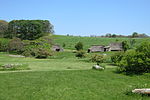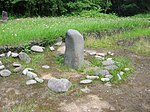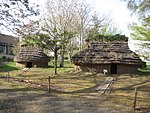Jōmon Prehistoric Sites in Northern Japan (北海道・北東北の縄文遺跡群) is a serial UNESCO World Heritage Site consisting of 17 Jōmon-period archaeological sites in Hokkaidō and northern Tōhoku, Japan. The Jōmon period lasted more than 10,000 years, representing "sedentary pre-agricultural lifeways and a complex spiritual culture of prehistoric people".[2]
| UNESCO World Heritage Site | |
|---|---|
 | |
| Location | Japan |
| Criteria | Cultural: (iii)(v) |
| Reference | 1632 |
| Inscription | 2021 (44th Session) |
| Area | 141.9 ha (0.548 sq mi) |
| Buffer zone | 984.8 ha (3.802 sq mi) |
It was first placed on the World Heritage Tentative List in 2009.[3] In 2021, ICOMOS recommended the inscription in July of the revised serial nomination of seventeen sites under criteria iii and v.[4] It was then officially inscribed on the World Heritage List on 27 July 2021.[2]
Sites edit
All component sites have been designated for protection under the Law for the Protection of Cultural Properties, as Historic Sites or *Special Historic Sites ("ACA" column below).[4]
See also edit

References edit
- ^ 土偶 [Dogū] (in Japanese). Agency for Cultural Affairs. Retrieved 28 July 2021.
- ^ a b "Jomon ruins added to UNESCO World Heritage List". The Japan Times. 27 July 2021. Retrieved 28 July 2021.
- ^ "Jômon Archaeological Sites in Hokkaidô, Northern Tôhoku, and other regions". UNESCO. Retrieved 12 June 2012.
- ^ a b ICOMOS, ed. (2021). "Evaluations of Nominations of Cultural and Mixed Properties (WHC-21/44.COM/INF.8B1)" (PDF). UNESCO. pp. 339–349. Retrieved 24 July 2021.
- ^ "Jōmon Prehistoric Sites in Northern Japan : Multiple locations". UNESCO World Heritage Centre. Retrieved 28 July 2021.
- ^ "大平山元I遺跡 -日本最古の土器出土-" [Ōdaiyamamoto Ichi Site - Excavation of Japan's Earliest Earthenware] (in Japanese). Aomori Prefecture. Retrieved 12 June 2012.
- ^ "青森県三内丸山遺跡出土品" [Excavated Artefacts from the Sannai-Maruyama Site] (in Japanese). Agency for Cultural Affairs. Retrieved 12 June 2012.
- ^ "陸奥国是川遺跡出土品" [Excavated Artefacts from the Korekawa Site] (in Japanese). Agency for Cultural Affairs. Retrieved 12 June 2012.
















